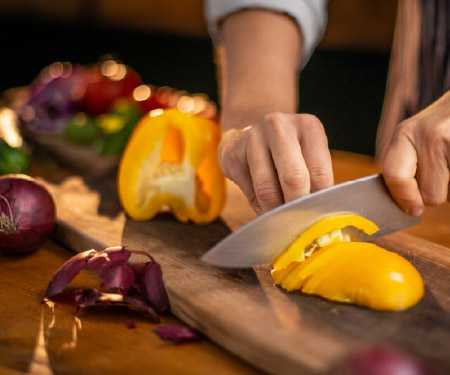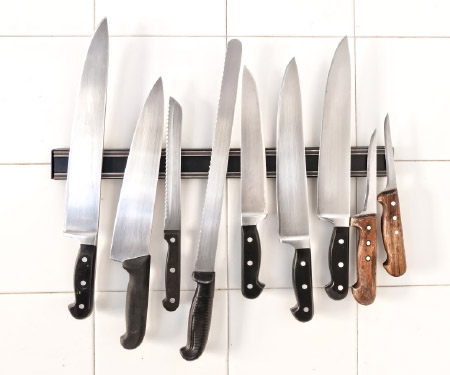
Cooking Class: Knife Skills
Knives are a valuable culinary tool and kitchen staple. However, there’s no particular knife that’s perfect for everyone. With varying handles, blades, weights and uses, there are numerous options. To make your time in the kitchen easier, safer and more efficient, choose knives that feel the most secure and natural to you. Use our knife tips and tricks to choose the perfect knives and cut with confidence.
Sharpen Your Knife Skills
• Get a Grip: The grip plays a huge role in improving your knife skills and ensuring safety. To prep ingredients more efficiently and avoid injury, hold high on the knife’s handle with your thumb and index finger gripping the blade’s heel. Most importantly, you should be comfortable and at ease while cutting.

• Set in Motion: The motion of chopping straight up and down dulls the blade’s edge. Instead, use a sliding or rocking motion and always maintain contact with the cutting board. When scraping food off a board, flip the knife and use the spine,
not the blade.
• Maintain Focus: Chopping ingredients may seem like a repetitive activity requiring minimal attention, but it’s crucial to stay focused when handling knives. Deciding your approach before you begin chopping will help you thoughtfully prep your ingredients and prevent accidents.
• Keep it Clean: The high temperatures of the dishwasher will dull your knives. Instead, clean with dish soap and hot water and dry immediately.
Knife Care
• Sharpen Yearly: Surprisingly, it’s easier to cut yourself with a dull blade than with a sharp one. The force needed to cut with a dull knife is more likely to cause injury. Sharpen your knives yearly using a sharpening stone (a flat brick of synthetic abrasives), steel (slightly abrasive steel rod), or your preferred sharpening tool. No matter what tool you use, be sure to hold the knife’s edge at a consistent angle, then wash with hot water and dry thoroughly.
• Storage: Storage plays a significant role in knife maintenance. To protect your knives and make them easily accessible, keep them on magnetic strips. Wooden blocks are also a great option, but the motion of repeatedly removing and replacing the knife to the block may dull the blade over time. If storing in a drawer, use blade sleeves to protect the edges.

Essential Knives for Any Kitchen
• Chef’s: Also known as a French knife, this kitchen workhorse does everything from mincing garlic and chopping onions to cutting whole chickens. Use the knife tip for trimming, peeling or scoring foods, and use the flat side of the blade to crush garlic. A good blade length is about 8 inches.
• Paring: A paring knife is short, easy to handle and best for detail work, such as peeling and cutting soft fruits or boiled potatoes, and hulling strawberries. Its rigid blade is about 3 to 4 inches long.
• Boning: Use a boning knife for the intricate work of trimming silver skin from tenderloins, removing the breast from a whole chicken or separating meat from the bone. It’s incredibly narrow, and the thin blade can be flexible or rigid with a length of 5 to 7 inches.
• Serrated Utility: This knife is suitable for various tasks, including cutting large cuts of meat, thin-skinned fruits like tomatoes, slicing citrus and cutting blocks of chocolate and bread. The blade is slightly flexible and between 10 and 12 inches long.
